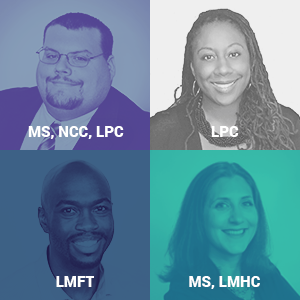Updated on 3/3/2022
All types of cognitive behavioral therapy (CBT) are based on the cognitive model of emotional response. This model conveys that how you feel and behave is based on your thoughts, not external stimuli. Different types of CBT can help you recognize and change negative or destructive thought patterns as they arise. By working towards consistently changing these thought patterns, you can have a more positive outlook on life.
The ultimate goal, regardless of which type of CBT you use, is to learn how to replace any negative or harmful thoughts that arise with more balanced, realistic, or positive ones. Through talk therapy, you’ll learn strategic coping skills that’ll help you navigate your own life during the good times and the bad.
What is Cognitive Behavioral Therapy?
Cognitive behavioral therapy is a type of talk therapy that focuses on problem-solving and meeting specific goals. The problem-solving skills you learn in treatment will help you identify and address difficulties from everyday stressors.
Cognitive behavioral therapy utilizes five problem-solving steps:
Licensed Therapists Online
Need convenient mental health support? Talkspace will match you with a therapist within days.
Cognitive Behavioral Therapy Online
Start CBT to learn to identify and reframe negative thought patterns and develop positive coping skills
- Recognize the problem.
- Create a list of potential solutions.
- Evaluate each of these solutions to determine the strengths and weaknesses they’ll offer you in your life.
- Choose which solution to apply to the problem.
- Implement the decided-upon solution.
CBT has proven so effective and successful that it has led to the development of additional specialized types of CBT.
What Are the Different Types of CBT?
The type of CBT you receive depends on the issues being addressed. Different types of cognitive therapy can include:
Mindfulness-based cognitive therapy (MBCT)
This form of CBT combines cognitive behavior therapy with meditation and helps cultivate a non-judgmental, present-oriented attitude, which is referred to as mindfulness.
MBCT can effectively help you deal with:
Dialectical behavior therapy (DBT)
Wondering what the difference is between DBT vs CBT?
Dialectical behavior therapy (DBT) is another evidence-based type of cognitive therapy that uses strategies like problem solving and finding acceptance. DBT is highly effective for the treatment of powerful emotions and severe mental health conditions. Those who benefit from DBT tend to see things in black and white. They view situations as one way or the other. They may not be able to see a middle ground or find a grey area. DBT can potentially help if you lack coping skills and find that you move from one crisis to another. Dialectical behavior therapy can also help you gain the skills you need to cope in a more effective manner.
DBT is known to effectively help those struggling with:
- Borderline personality disorder
- Bipolar disorder
- Substance abuse
- ADHD
- Eating disorders
- Post Traumatic Stress Disorder (PTSD)
Acceptance and commitment therapy (ACT)
This behaviorally-oriented CBT technique relies heavily on positive reinforcement and counter-conditioning. The goal of ACT is to change how you respond to your inner experiences.
Inner experiences include:
- Emotions
- Thoughts
- Impulses
- Physical feelings
Acceptance and commitment therapy teaches you how to stop denying, avoiding, and struggling with your inner emotions. You’ll learn how to acknowledge deeper feelings. As you move through talk therapy, you may begin to realize that your feelings can be appropriate responses to certain situations. Once you grasp this way of thinking, you can start accepting the hardships and issues you’re experiencing. This acceptance allows you to make the behavioral changes necessary to improve your life.
ACT can help you learn how to cope with:
- Depression
- Social anxiety disorder
- Stress in the workplace
- Psychosis
- Obsessive compulsive disorder (OCD)
- Test anxiety
- Chronic pain
- Substance abuse and addiction
Rational emotive behavior therapy (REBT)
REBT is an active-oriented therapy approach that helps you identify irrational beliefs like self-defeating feelings and thoughts. You’ll learn how to actively challenge irrational thoughts and eventually be able to recognize and change your thought patterns. Ultimately, REBT teaches you to replace negative thoughts with healthier, more productive beliefs.
REBT is one of the types of CBT that’s been shown effective in treating individuals dealing with:
- Anxiety
- Guilt
- Depression
- Inappropriate or extreme anger
- Unhealthy eating
- Aggression
- Procrastination
Therapeutic Techniques of CBT
Which type or types of cognitive therapy treatment you get is based on the areas of life you want to address in talk therapy.
There are a number of types of CBT treatment techniques that mental healthcare providers will use. Some of the most common treatment techniques include:
Cognitive restructuring/reframing
By taking an in-depth look at your negative thought patterns, you can begin to reframe them into more productive, positive ones. This CBT technique might be useful if you’re the type who over-generalizes, puts too much importance on things that are relatively minor, or constantly assumes the worst outcome is inevitable.
Exposure therapy
This is an excellent CBT technique for addressing phobias and overcoming fears. Exposure therapy helps you learn how to face the things you find most difficult in life. In the end, exposure therapy can help you gain confidence and feel less vulnerable in certain situations.
Role playing
When you’re able to play out scenarios that would typically induce stress or fear in your life, you can learn how to alter your behavior. Role play has been found successful for developing healthy problem solving skills, gaining confidence and assertiveness, enhancing communication skills, and defining and improving social skills.
Meditation
During a meditative practice, concentration areas include inner thoughts, breathing sensations, sound, and specific areas of the body. If your mind begins to wander, you’ll learn to bring your attention back to the things that you were focusing on. Some find that practicing Tai Chi and yoga is helpful in focusing and developing an awareness of breathing.
Journaling
Several writing activities are often used with CBT. Listing negative thoughts and positive affirmations can both be helpful ways to continue growth between therapy sessions. You might also track any new thought patterns and behaviors you’re learning as you see them happening. This can be an effective way to chart progress along your journey, which can be very motivating.
Progressive muscle relaxation
To use progressive muscle relaxation, you learn to tense a specific muscle group or body part for 5 to 7 seconds and then rest for up to 30 seconds. This technique can be helpful to learn the difference between relaxation and tension.
“One easy strategy my clients have found helpful is to clench your hands into very tight fists and hold for 5 to 7 seconds and then sharply release your hands, spreading out your fingers widely like fireworks or jazz hands. You will notice a release of tension and energy and it can be done almost anywhere very easily.”
What Are the Benefits of Cognitive Behavioral Therapy?
All types of cognitive therapy provide a way to effectively deal with common stressors. CBT offers many benefits, including:
- It’s powerful – Allows you to recognize negative and unrealistic thoughts that affect your mood.
- It’s versatile – Can be an effective treatment for an array of maladaptive behaviors.
- It’s long-lasting – Helps you develop useful coping skills and tools that can help you throughout your life.
- It’s convenient – CBT is available in-person or remotely through telehealth, online, or video counseling services.
- It can offer quick results – Many people begin to see positive results in a short amount of time, sometimes in as few as five sessions.
- It’s affordable – CBT can be more affordable than some other therapy options.
“Cognitive Behavioral Therapy has such a powerful impact in people’s lives. Being able to impact long standing challenges by developing skills and strategies to help each day while processing your thoughts and feelings at the same time with a therapist is life changing.”
How To Get Started With CBT
Since there are several types of cognitive behavioral therapy available, it can be effective for a wide range of psychological conditions. However, before starting treatment, you might want to contact your health insurance provider to find out what type of coverage you have through your plan.
If you need a referral to receive CBT, you may want to start the process with your primary care doctor to make sure your insurance will cover your treatment. You should also ask about in-network vs. out of network providers, as there may be a big difference in cost if you use a provider outside your network. If you’re looking for online therapy that takes insurance, get connected at Talkspace and check your eligibility today.
If you don’t have insurance, there are a number of affordable options out there for you to choose from. A CBT therapist may offer sliding scale fees, where you pay what you can afford, and there are even low- or no-cost community clinics and support groups you might be able to find for therapy. If you’re thinking about exploring any of the types of CBT we’ve discussed here today, try taking those first steps. Your mental health is one of the most important parts of your life, and getting treatment can change everything.
“While it can seem daunting to get started, your mental wellness is crucial and impacts many areas of life. Just like many people take care of their physical health through exercise and nutrition, taking the first step to take care of your mental health may be the hardest, but is a sign of strength. Don’t hesitate to reach out!”
Sources:
1. Twohig, M.P., Woidneck, M. R., & Crosby, J. M. (2013) Newer generations of CBT for anxiety disorders. In G. Simos & S. G. Hofmann (Eds.), CBT for anxiety disorders: A practitioner book (pp. 2250=-250). Wiley Blackwell. https://psycnet.apa.org/record/2014-08969-009. Accessed August 28, 2021.
2. What is Cognitive Behavioral Therapy?. https://www.apa.org. https://www.apa.org/ptsd-guideline/patients-and-families/cognitive-behavioral. Published 2017. Accessed August 28, 2021.
3. Learning to Relax. Rogel Cancer Center | University of Michigan. https://www.rogelcancercenter.org/breaking-habits-beating-us/learning-relax. Accessed August 28, 2021.
Talkspace articles are written by experienced mental health-wellness contributors; they are grounded in scientific research and evidence-based practices. Articles are extensively reviewed by our team of clinical experts (therapists and psychiatrists of various specialties) to ensure content is accurate and on par with current industry standards.
Our goal at Talkspace is to provide the most up-to-date, valuable, and objective information on mental health-related topics in order to help readers make informed decisions.
Articles contain trusted third-party sources that are either directly linked to in the text or listed at the bottom to take readers directly to the source.




